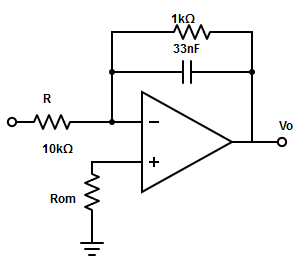This set of Linear Integrated Circuit Multiple Choice Questions & Answers (MCQs) focuses on “Integrator – 1″.
1. The circuit in which the output voltage waveform is the integral of the input voltage waveform is called
a) Integrator
b) Differentiator
c) Phase shift oscillator
d) Square wave generator
View Answer
Explanation: Integrator circuit produces the output voltage waveform as the integral of the input voltage waveform.
2. Find the output voltage of the integrator
a) Vo = (1/R×CF)×t∫0 Vindt+C
b) Vo = (R/CF)×t∫0 Vindt+C
c) Vo = (CF/R)×t∫0 Vindt+C
d) Vo = (R×CF)×t∫0 Vindt+C
View Answer
Explanation: The output voltage is directly proportional to the negative integral of the input voltage and inversely proportional to the time constant RCF.
Vo = (1/R×CF)×t∫0 Vindt+C
Where C-> Integration constant and CF-> Feedback capacitor.
3. Why an integrator cannot be made using low pass RC circuit?
a) It require large value of R and small value of C
b) It require large value of C and small value of R
c) It require large value of R and C
d) It require small value of R and C
View Answer
Explanation: A simple low pass RC circuit can work as an integrator when time constant is very large, which require large value of R and C. Due to practical limitations , the R and C cannot be made infinitely large.
4. How a perfect integration is achieved in op-amp?
a) Infinite gain
b) Low input impedance
c) Low output impedance
d) High CMRR
View Answer
Explanation: In an op-amp integrator the effective input capacitance becomes CF×(1-Av). Where Av is the gain of op-amp. The gain is infinite for ideal op-amp. So, effective time constant of the op-amp integrator becomes very large which results in perfect integration.
5. The op-amp operating in open loop result in output of the amplifier to saturate at a voltage
a) Close to op-amp positive power supply
b) Close to op-amp negative power supply
c) Close to op-amp positive or negative power supply
d) None of the mentioned
View Answer
Explanation: In practice, the output of op-amp never becomes infinite rather the output of the op-amp saturate at a voltage close to op-amp positive or negative power supply depending on the polarity of the input dc signal.
6. The frequency at which gain is 0db for integrator is
a) f=1/(2πRFCF)
b) f=1/(2πR1CF)
c) f=1/(2πR1R1)
d) f=(1/2π)×(RF/R1)
View Answer
Explanation: The frequency at which the gain of the integrator becomes zero is f=1/(2πR1CF).
7. Why practical integrator is called as lossy integrator?
a) Dissipation power
b) Provide stabilization
c) Changes input
d) None of the mentioned
View Answer
Explanation: To avoid saturation problems, the feedback capacitor is shunted by a feedback resistance(RF). The parallel combination of RF and CF behave like a practical capacitor which dissipates power. For this reason, practical integrator is called as a lossy integrator.
8. Determine the lower frequency limit of integration for the circuit given below.

a) 43.43kHz
b) 4.82kHz
c) 429.9kHz
d) 4.6MHz
View Answer
Explanation: The lower frequency limit of integration, f= 1/(2πRFCF) = 1/(2π×1kΩ×33nF) = 4.82kHz.
Sanfoundry Global Education & Learning Series – Linear Integrated Circuits.
To practice all areas of Linear Integrated Circuits, here is complete set of 1000+ Multiple Choice Questions and Answers.
If you find a mistake in question / option / answer, kindly take a screenshot and email to [email protected]
